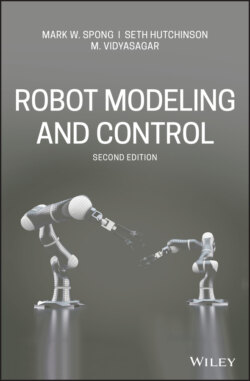Читать книгу Robot Modeling and Control - Mark W. Spong - Страница 36
Chapter 3: Forward Kinematics
ОглавлениеTypically, the manipulator will be able to sense its own position in some manner using internal sensors (position encoders located at joints 1 and 2) that can measure directly the joint angles θ1 and θ2. We also need therefore to express the positions A and B in terms of these joint angles. This leads to the forward kinematics problem studied in Chapter 3, which is to determine the position and orientation of the end effector or tool in terms of the joint variables.
It is customary to establish a fixed coordinate system, called the world or base frame to which all objects including the manipulator are referenced. In this case we establish the base coordinate frame o0x0y0 at the base of the robot, as shown in Figure 1.19. The coordinates (x, y) of the tool are expressed in this coordinate frame as
Figure 1.19 Coordinate frames attached to the links of a two-link planar robot. Each coordinate frame moves as the corresponding link moves. The mathematical description of the robot motion is thus reduced to a mathematical description of moving coordinate frames.
(1.1)
(1.2)
in which a1 and a2 are the lengths of the two links, respectively. Also the orientation of the tool frame relative to the base frame is given by the direction cosines of the x2 and y2 axes relative to the x0 and y0 axes, that is,
(1.3)
which we may combine into a rotation matrix
(1.4)
Equations (1.1), (1.2), and (1.4) are called the forward kinematic equations for this arm. For a six-DOF robot these equations are quite complex and cannot be written down as easily as for the two-link manipulator. The general procedure that we discuss in Chapter 3 establishes coordinate frames at each joint and allows one to transform systematically among these frames using matrix transformations. The procedure that we use is referred to as the Denavit–Hartenberg convention. We then use homogeneous coordinates and homogeneous transformations, developed in Chapter 2, to simplify the transformation among coordinate frames.
